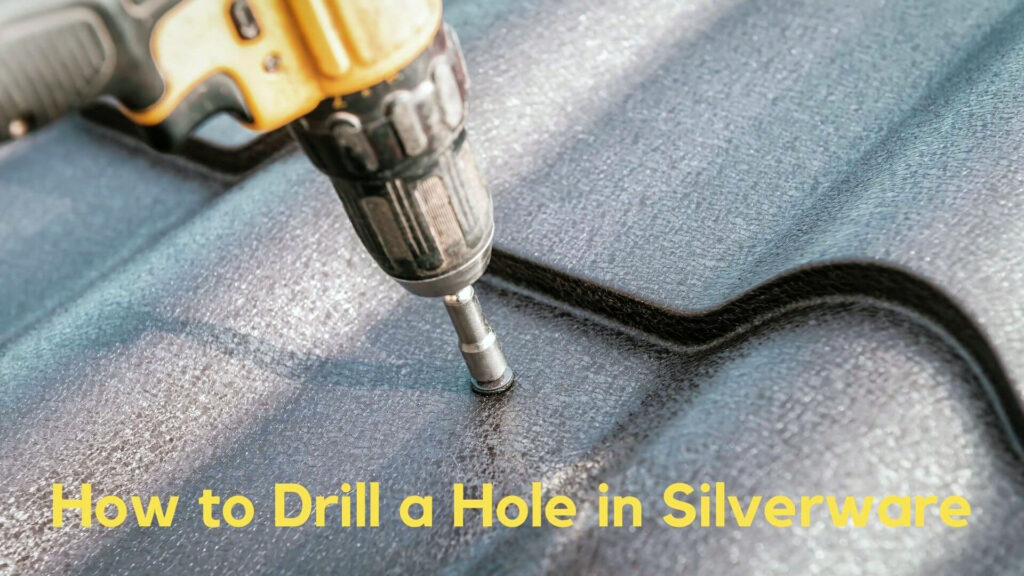Drilling a hole in silverware might seem like an unusual project, but it can open up a world of creative possibilities. Whether you’re making jewelry, crafting home decor, or repurposing old utensils, knowing how to safely and effectively drill a hole in silverware is an essential skill for DIY enthusiasts.
This simple trick can help you drill into metal with minimal effort, transforming your cutlery into unique, artistic creations. In this post, we’ll walk you through the process step-by-step, with tips and techniques to ensure success.
Table of Contents
What is Drill A Hole In Silverware?

Drilling a hole in silverware refers to creating a small opening in a piece of cutlery, such as a fork, spoon, or knife, for various crafting or decorative purposes. This technique is commonly used in making jewelry, wind chimes, keychains, or even furniture. By drilling into silverware, you can add hooks, loops, or fasteners to repurpose the utensils in a fun and creative way.
Whether you’re using antique silverware or more common flatware, drilling a hole allows you to reimagine and recycle old pieces, giving them a new purpose.
Check Also: how to drill carbon fiber
Gathering Your Tools
Before getting started, it’s important to gather the right tools to ensure that your project goes smoothly. Here’s what you’ll need:
- Cordless Drill or Electric Drill: A regular household drill will work fine, but ensure it’s powerful enough to handle metal.
- Drill Bits: You’ll need drill bits specifically designed for metal, such as titanium or cobalt bits. Choose the right size based on the hole you need.
- Clamps: To keep the silverware stable during drilling.
- Masking Tape: Helps prevent the drill bit from slipping when starting the hole.
- Safety Gear: Goggles and gloves to protect your eyes and hands from metal shavings.
- Sandpaper: To smooth the edges of the hole once it’s drilled.
6 Easy Steps to Drill A Hole In Silverware
Now that you have your tools ready, it’s time to dive into the step-by-step process of drilling a hole in silverware.
Step 1: Choose The Right Drill Bit
The first step is selecting the appropriate drill bit for the job. Because you’ll be working with metal, a cobalt or titanium drill bit is best suited for drilling into silverware. These bits are designed to cut through metal with ease and will remain sharp for longer. Select the drill bit size based on how big you want the hole to be; smaller bits are easier to control, while larger bits may require more effort and precision.
Step 2: Position The Drill And Hold It Firm
Secure your piece of silverware using clamps or a vice grip to keep it stable during the drilling process. This will prevent any movement or slipping, which could lead to accidents or inaccurate drilling. Use a flat surface and position the drill bit on the spot where you want the hole. If you’re concerned about the drill bit wandering, you can apply a piece of masking tape to the area where you’ll be drilling, as it helps to create friction and hold the bit in place.
Step 3: Apply Pressure To The Drill Bit
When drilling into metal, a little bit of pressure is necessary to help the drill bit cut through the material. Don’t push too hard, though—just enough to allow the bit to make a mark and begin penetrating the surface. Too much force could result in the bit breaking or the silverware bending, depending on its thickness.
Step 4: Drill At A Slow Pace
It’s essential to drill at a slow, controlled speed when working with metal. High-speed drilling generates heat, which can damage the bit and cause the silverware to become too hot to handle. Keep the drill steady, allowing the bit to do most of the work. If you find the metal heating up, take short breaks to let it cool or apply some lubricating oil to reduce friction.
Step 5: Use A Template To Get The Right Hole Size
If you’re creating multiple holes in different pieces of silverware or need precise placement, using a template can help ensure accuracy. You can create a template from cardboard or a thin piece of metal to guide the drill bit to the correct spot every time.
Step 6: Sand The Edges Smoothly
Once you’ve successfully drilled the hole, you’ll likely notice rough or sharp edges around the hole. Use fine sandpaper to smooth out these edges, preventing injury and giving the hole a clean, polished look. This step is particularly important if you’re turning your silverware into jewelry or other items that will be handled frequently.
Tips for Success
Use Masking Tape: To prevent the drill bit from slipping, apply masking tape to the area where you plan to drill. This will help the drill bit grip the metal surface.
Lubricate the Drill Bit: Using lubricating oil can reduce friction and heat, making the drilling process easier and extending the life of your drill bit.
Drill Slowly: Rushing through metal can cause overheating and lead to dull drill bits or broken utensils.
Safety First: Always wear safety goggles and gloves to protect yourself from flying metal shavings.
How to Reuse Old Silverware?
Once you’ve drilled holes into your old silverware, there are endless ways to reuse them. Here are some creative ideas:
- Jewelry: Make custom necklaces, earrings, or bracelets by attaching chains or beads through the holes in the silverware.
- Wall Art: Hang silverware on the wall in a decorative pattern or use it to create a unique, artistic piece of wall decor.
- Keychains: Turn spoons and forks into unique keychains by adding a ring through the drilled hole.
- Wind Chimes: String several pieces of silverware together to create a whimsical wind chime.
- Coat Hooks: Bend silverware into hook shapes and attach them to a wooden board for a rustic coat or key holder.
Check Also: how to make holes in the plastic
Advantages Of Drill A Hole In Silverware
Repurposing Old Utensils: Drilling a hole in silverware allows you to recycle old utensils, giving them new life as decorative items, jewelry, or practical household items.
Easy Customization: Once you’ve drilled a hole, you can customize your silverware however you want, adding hooks, chains, or other materials to create unique, personal items.
Saves Money: Instead of purchasing new craft materials, you can reuse old utensils, making your projects more cost-effective.
FAQs
Can I use a regular household drill for this?
Yes, a regular household drill can be used to drill into silverware, but ensure you have a metal-appropriate drill bit, such as a cobalt or titanium bit.
What type of silverware works best for this trick?
Stainless steel or sterling silver utensils work best. Avoid very cheap, thin metal silverware as it may bend or break during drilling.
How can I prevent the drill bit from wandering?
To prevent the drill bit from wandering, apply a piece of masking tape over the area you plan to drill. You can also use a center punch to create a small dent for the drill bit to follow.
What if the drill bit breaks during drilling?
If the drill bit breaks, stop immediately, remove the broken piece, and replace it with a fresh drill bit. Drilling slowly and with proper lubrication can help prevent this from happening.
Can I use this trick for other types of metal?
Yes, the same process can be used for other soft metals, such as aluminum or copper. However, harder metals may require different tools and more specialized techniques.
Can I use a larger drill bit for a larger hole?
Yes, you can use a larger drill bit if you need a larger hole, but make sure to drill slowly and use appropriate safety precautions.
Final Word
Drilling a hole in silverware opens up a world of creative possibilities, from custom jewelry to home decor. With the right tools, a steady hand, and the simple trick of drilling slowly and using proper lubrication, you can safely and effectively drill into metal utensils for a variety of projects. Remember to follow the safety tips, choose the right drill bit, and enjoy the satisfaction of repurposing old silverware into something new and unique. Happy crafting!

Hey, I am MD Hrithik Hossain, I’m a huge fan of DIY crafts. My workshop is where I spend most of my spare time, and I’m always working on some project. To that end, I’d like to share some of my knowledge and experience with you in power tools, woodworking, and other specialized materials fabrication.
I will guide you with genuine knowledge that can assist you with deciding whether a drill is appropriate according to your requirements or not. If you want to find the best drill and know which type of drill is most suited for your needs, then I can guide you with my expertise. My passion lies in helping others find the correct products they need at an affordable price.


